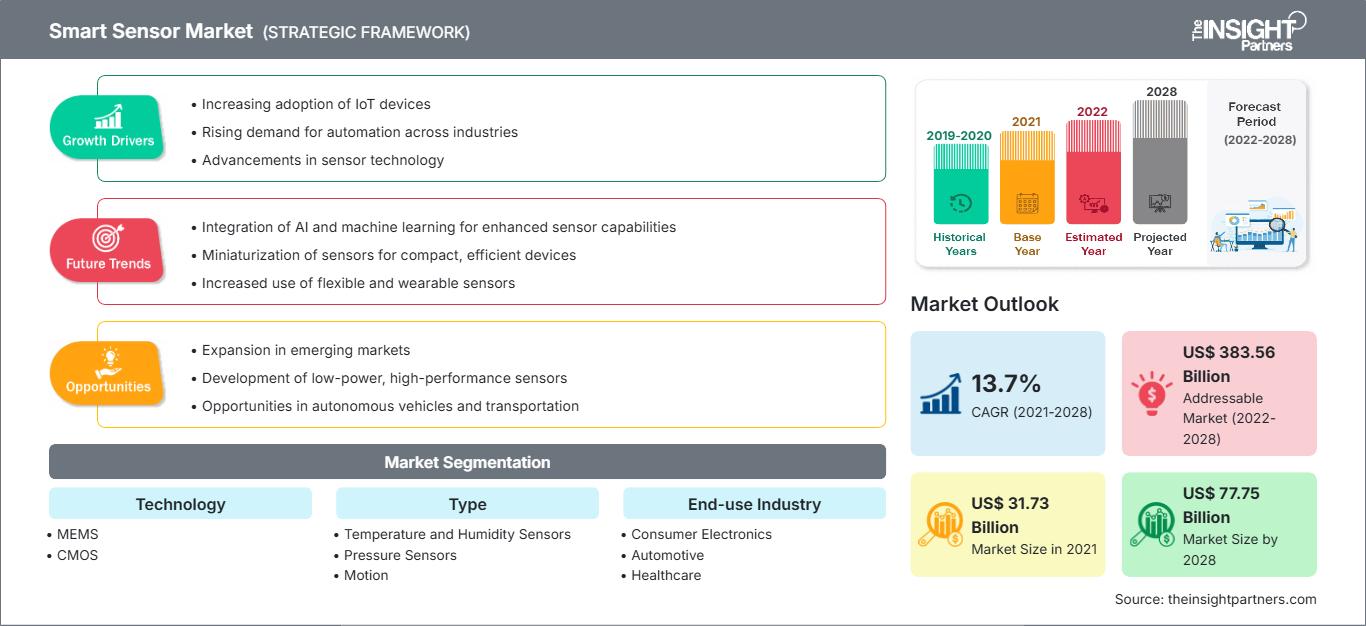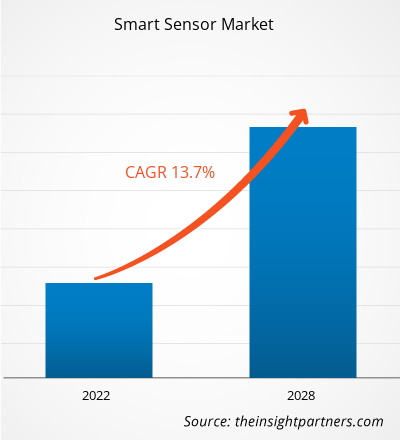预计智能传感器市场规模将从 2021 年的 317.311 亿美元增长到 2028 年的 777.476 亿美元。预计 2021 年至 2028 年期间的复合年增长率为 13.7%。
智能传感器比传统传感器更快、更准确。这些传感器比传统传感器更小、功耗更低。在过去几年中,智能传感器技术在基于物联网的设备和消费电子产品中的应用,以及其在航空航天和国防、汽车、生物医学和医疗保健、工业自动化、楼宇自动化、消费电子、教育、机器人、农业和交通运输行业的应用,引起了人们的极大兴趣。智能传感器在各种应用中的使用率增加是推动智能传感器市场规模增长的关键因素。
随着人们对安全和安保问题的日益关注,消费电子产品对智能传感器的需求也在不断增长,从而对智能传感器市场产生了影响。家庭自动化中使用各种传感器,例如夜视红外传感器、声音传感器或麦克风以及智能马桶。各公司将各种功能融入其智能传感器中,例如自动清洁、自动冲水、水箱泄漏监测、溢水保护和健康监测。灯光和风扇可以通过使用红外或运动传感器的自动系统进行控制。此外,随着生活方式的改变和现代生活水平的提高,集成家庭自动化的模块化厨房的需求呈指数级增长,对智能传感器市场产生了积极影响。制造商正在开发基于合成传感器的设备,以监测振动、厨房声音、光线、气体、温度、热量以及电磁温度和噪声,从而扩大了智能传感器的市场规模。例如,Analog Devices, Inc. 提供 HMC1126 GaAs pHEMT 传感器。它是一种低噪声放大器,工作频率范围为 400 MHz-52 GHz,可用于微波无线电、甚小孔径终端 (VSAT)、测试设备和 5G 通信等多种应用。
自定义此报告以满足您的要求
您将免费获得任何报告的定制,包括本报告的部分内容,或国家级分析、Excel 数据包,以及为初创企业和大学提供超值优惠和折扣
智能传感器市场: 战略洞察

-
获取本报告的主要市场趋势。这个免费样本将包括数据分析,从市场趋势到估计和预测。
智能传感器技术推动了智能手机和可穿戴设备的快速技术进步。汽车制造商对智能传感器的需求日益增长,以提高安全性和舒适度。使用无线技术监控和控制配备智能传感器的安全设备正变得越来越普遍。在新冠疫情 (COVID-19) 期间,对支持智能传感器的可穿戴设备的需求激增,政府对绿色建筑建设的持续支持以及预测性维护,为智能传感器市场参与者提供了丰厚的机遇。
智能手机普及率的上升极大地推动了智能传感器市场的增长。智能传感器包括运动传感器、位置传感器、环境光传感器、加速度计和陀螺仪等常用传感器。比吸收率 (SAR) 传感器增强了各种无线技术的连接性,例如智能手机、平板电脑和笔记本电脑中的 5G sub-6/4G/Wi-Fi。领先的半导体供应商 SEMTECH 提供 PerSeTM Connect、PerSe Connect Pro 和 PerSe Control 传感器,可用于智能手机、笔记本电脑、平板电脑和可穿戴设备等各种应用。
许多公司正在开发新型先进智能传感器,将微控制器集成在一个封装中。人工智能 (AI) 和物联网 (IoT) 等现代技术使这种组合能够在小封装内实现。例如,博世 Sensortec 的 BHA250 可将 32 位微控制器与 14 位加速度传感器集成在一个 2.2 x 2.2 x 0.95 立方毫米的封装中。此外,TE Connectivity 公司已将传感器与连接器集成,从而将功能集成到小空间中。智能传感器技术的这些发展正在对智能传感器市场的增长产生积极影响。随着消费电子行业的蓬勃发展,例如智能饮料自动售货机、智能家居自动化系统、简易电脑、数字助理(例如 Alexa)以及可穿戴设备,智能传感器市场对智能传感器的需求也随之增长。随着消费者不断接受可穿戴设备、声控智能音箱和智能家居设备等新兴产品,笔记本电脑、智能手机和电视等传统消费产品的表现持续超出预期。
多项研究表明,未来几年将有数百亿台物联网设备连接到互联网,这将对智能传感器市场产生巨大影响。随着各城市政府适应新的现实,新冠疫情正在推动城市韧性和数字化转型战略议程。
新冠疫情对智能传感器市场的影响
新冠疫情的出现,使得利用数字基础设施进行远程患者监控的需求成为人们关注的焦点。由于目前病毒检测和疫苗研发缓慢,人们已确定更强大的疾病检测以及个人和群体健康监测的需求日益增长,而可穿戴传感器可以提供帮助。虽然这项技术已用于将生理指标与日常生活和人体机能关联起来,但仍有必要将其应用于预测COVID-19的发生。
节能设备需求的不断增长,推动了北美智能传感器市场对智能传感器的需求。由于不断变化的市场环境需要节能设备和产品,企业正在转向节能设备。此外,随着政府严格法规的解除,各行各业对智能传感器市场的需求也在增长,这些法规在自动化行业也越来越受到关注。此外,汽车行业对传感器的需求也受到减轻汽车平均重量的渴望的推动。轻量化汽车有助于提高燃油效率和能源优化。
智能传感器市场
The Insight Partners 的分析师已详尽阐述了预测期内影响智能传感器市场的区域趋势和因素。本节还讨论了北美、欧洲、亚太地区、中东和非洲以及南美和中美洲的智能传感器市场细分和地域分布。
智能传感器市场报告范围
| 报告属性 | 细节 |
|---|---|
| 市场规模 2021 | US$ 31.73 Billion |
| 市场规模 2028 | US$ 77.75 Billion |
| 全球复合年增长率 (2021 - 2028) | 13.7% |
| 历史数据 | 2019-2020 |
| 预测期 | 2022-2028 |
| 涵盖的领域 |
By 技术
|
| 覆盖地区和国家 |
北美
|
| 市场领导者和主要公司简介 |
|
智能传感器市场参与者密度:了解其对业务动态的影响
智能传感器市场正在快速增长,这得益于终端用户需求的不断增长,而这些需求的驱动因素包括消费者偏好的不断变化、技术进步以及对产品优势的认知度不断提高。随着需求的增长,企业正在扩展其产品线,不断创新以满足消费者需求,并抓住新兴趋势,从而进一步推动市场增长。

- 获取 智能传感器市场 主要参与者概述
智能传感器市场细分
根据技术,智能传感器市场细分为 MEMS、CMOS 和其他。2021 年,MEMS 细分市场占据市场主导地位。根据类型,智能传感器市场细分为温度和湿度传感器、压力传感器、运动传感器、位置传感器和其他。2021 年,温度和湿度传感器细分市场占据最大市场份额。根据最终用途行业,智能传感器市场细分为消费电子、汽车、医疗保健、制造、零售和其他。
Analog Devices Inc.、Infineon Technologies Inc.、STMicroelectronics、TE Connectivity、Microchip Technologies、NXP Semiconductor、Siemens AG、ABB Ltd.、Robert Bosch GmbH 和 Honeywell International 是智能传感器市场的主要参与者。除此之外,还对其他几个参与者进行了分析,以了解全球智能传感器市场的整体动态。
- 历史分析(2 年)、基准年、预测(7 年)及复合年增长率
- PEST和SWOT分析
- 市场规模、价值/数量 - 全球、区域、国家
- 行业和竞争格局
- Excel 数据集
近期报告
相关报告
客户评价
购买理由
- 明智的决策
- 了解市场动态
- 竞争分析
- 客户洞察
- 市场预测
- 风险规避
- 战略规划
- 投资论证
- 识别新兴市场
- 优化营销策略
- 提升运营效率
- 顺应监管趋势






















 获取免费样品 - 智能传感器市场
获取免费样品 - 智能传感器市场